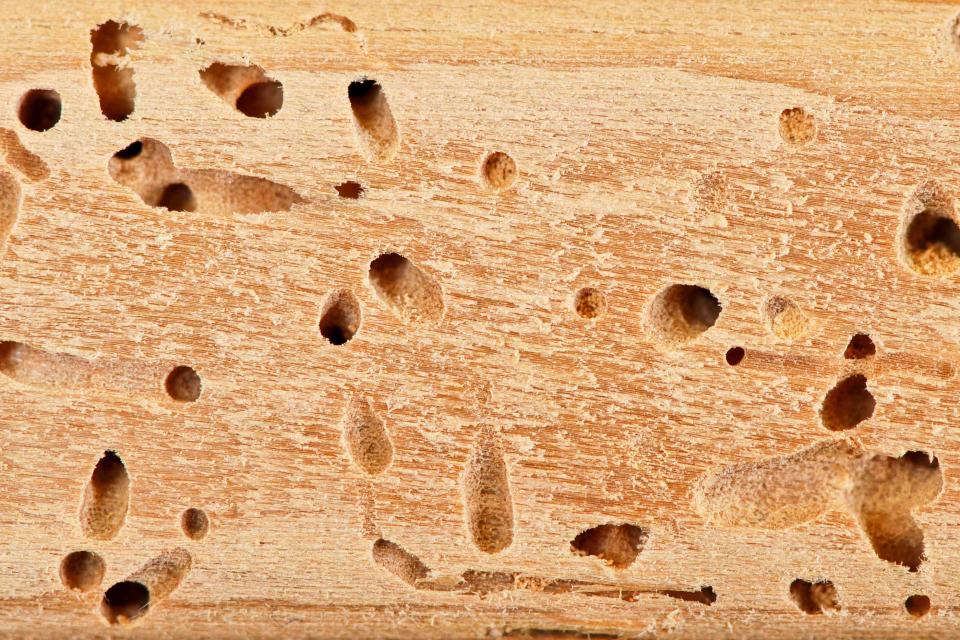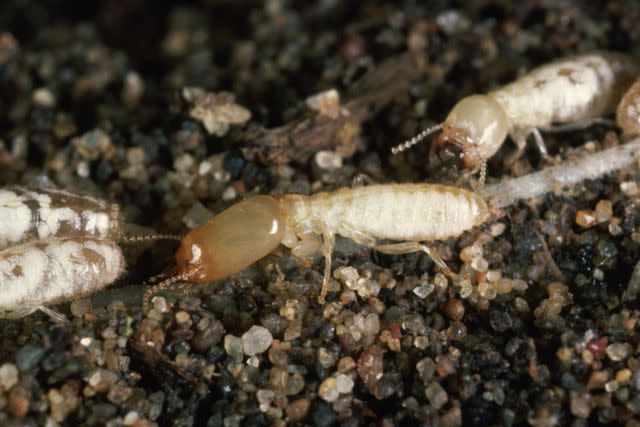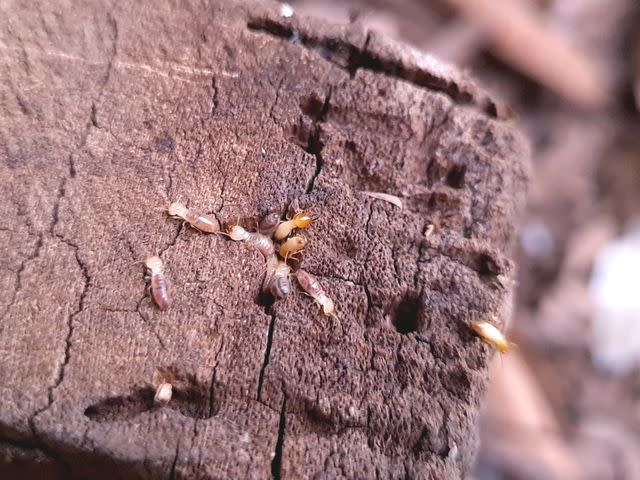How to Get Rid of Termites Safely and Effectively
Give these hungry bugs the boot with expert advice.

Ilbusca/Getty Images
Termites are some seriously hungry critters. They’ll munch on just about anything containing cellulose, which is found in plant fiber used to make paper and wood products. Termites will snack on all kinds of wood materials, magazines, newspapers, cardboard boxes, and more. They’ll literally eat you out of house and home, and the worst part is that by the time you spot one, the issue is probably pretty serious.
According to Doug Webb, a board certified entomologist and the termite technical services manager for Terminix, “Unfortunately, termites are very cryptic insects and often go undetected in homes, sometimes for several years before they are discovered. They usually feed on the wood that frames and supports the structure, where they are protected from temperature and moisture extremes.” And where they are protected from your eyeballs. So once you spot one, you need to act quickly. Here’s how to get rid of termites safely and effectively.
Related: How to Keep Animals Out of Your Garden Without Losing Your Mind
Termite Types
Identifying the type of termite has taken up residence in your home will help you or professionals determine the course of treatment you should take. In general, termites are sometimes mistaken for ants, but Webb says there are some key distinctions. Termites have a straight waist, while ants have pinched waists like wasps, and most termites vary in color from black to light brown or amber, depending on the species. (Ants are red, black, or dark brown.) Termites have straight antennae and ants have “elbowed” or L-shaped antennae. Below are the most common species of termites you should look out for.
Subterranean Termites

George D. Lepp/Getty Images
Western Subterranean TermiteThis species of termites accomplishes a ton underground as the name suggests. “The nest and most of their colony activity is in the soil, often 6 to 20 feet below the surface,” Webb says. They thrive in the damp environment of the soil and will only enter homes only in search of food.
The eastern subterranean termite is the most common species of termites found in homes across much of the U.S., Webb says.
There is also a western subterranean termite species commonly found in western states.
Formosan and Asian termites are other species that have been introduced into some areas of the U.S. in recent years, according to Webb, especially in the southeastern states, and in Hawaii, with the highest concentrations along the Gulf Coast and in Hawaii. Formosans have become the dominant species in Hawaii and some of the Gulf Coast areas. Asian termites are mostly found in south Florida, but both of these species have been gradually expanding their range over the past few years. (Note that Formosan termites can swarm and land in the upper part of your house, establishing colonies without soil contact!)
Drywood termites

Cherdchanok Treevanchai/Getty Images
Drywood TermitesDrywood termites are unique in that they nest directly in wood, not in the soil, so different control measures must be used to control them, Webb says. Drywood termites are found commonly in central and southern California, Hawaii, and in central and south Florida. They are also found sporadically across some western states and along the Gulf Coast. Drywood termites are found in dry pieces of wood like the framing of your house, flooring, and even furniture.
Signs of Termite Infestation
Because termites work in secret for a long time, it might be difficult to confirm their presence. However, there are some signs you can look for.
Swarms
The most obvious sign of a termite infestation is, well, termites. If you see swarms of termites in particular emerging from your home, get a pro asap. “Swarming termites are the reproductive members of a termite colony that develop in mature termite colonies and fly away from the rest of the colony to start new colonies, usually in the spring or summer, depending on the species. Their only job is to start new colonies,” Webb says.
Mud Tubes
Another clue is shelter tubes, or mud tubes. These are tubes made of dirt and saliva and they’re used for traveling to and from the rest of the colony. The mud tubes provide shelter and security from temperature extremes and predators, so termites use them exclusively. According to Webb, these tunnels are built pretty much anywhere: “On the outside foundation of the house, on porch columns, in window sills, baseboards or door frames, and just about anywhere else in the home where wood or other cellulose containing materials are found, including the paper surfaces of sheet rock walls,” he adds.
Buckled Wood
Other signs of infestation are buckled flooring or wall coverings, and distorted surfaces of baseboards or other wood trim. Webb says that wood that has been damaged by termites may sound hollow if tapped. Also pay attention to blisters and soft spots in wood flooring!
Droppings and Discarded Wings
Drywood termites in particular leave behind fecal droppings on floors, window sills or other horizontal surfaces, Webb says. Termite droppings are oval and might look like a tiny grain. Other “remnants” of termites include discarded wings—they collectively shed their wings into piles before they start a new colony.
Cracked or Bubbling Paint
Because termites are boring away into your home, the holes they create allow moisture to permeate, resulting in bubbling or peeling paint.
DIY Methods to Get Rid of Termites
There are plenty of DIY products and concoctions out there that claim to control or even eliminate termites, and while individual termites are not hard to kill, colonies (which can have millions of members!) are extremely difficult to get rid of using just homemade solutions, according to Webb. You could start with the below methods and see how effective they are, but there’s a chance you’ll need to resort to stronger measures with help from a professional.
Termiticide
There are liquid and foam pesticides you can apply around your home to kill termites. Liquids can be sprayed on soil, mulch, or wood chips, while foams are a good option for hard-to-reach cracks and crevices. There are also dust and powder products for even-harder-to-reach cracks. The termiticides will kill the bugs upon contact and/or they’ll spread the poison to their colony.
Baits and Traps
Traps usually contain a poisoned bait, like wood, paper or cellulose, that the termites feed on and bring back to their colony. Most baits are slow-acting, allowing the termites to return to the colony and spread the bait to others.
Boric Acid
Spraying or sprinkling boric acid onto infested areas is a popular method as it kills termites through dehydration. You can buy pre-made versions or make your own by combining one teaspoon of boric acid powder with a cup of water in a spray bottle.
Physical Barriers
You can create physical barriers to prevent termite entry. For drywood termites, drill a hole in the infested piece of wood, fill it with termiticide, then putty over the holes. This is essentially trapping the termites with the poison.
Essential Oils
Essential oils are not intended for severe infestations, but orange or neem oil are considered natural pesticides and may work during the early stages. Orange oil will kill the termites, while neem oil will stop termites from reproducing.
Nematodes
Yep, this parasite is a powerful agent when it comes to termite destruction. They’re pretty much invisible to the naked eye and once they’re introduced to their host, they’ll slowly poison them. This is a good treatment option for subterranean termites—sprinkle the affected outdoor areas with potting soil, water, and nematodes.
Keep in mind that termites can continue to cause substantial damage to your home’s structure if they are not stopped, says Webb. This puts the DIY homeowner at risk for additional treatment costs as well as the repair of damages to the home that may occur.
Professional Treatment Options
DIY methods can be quite weak against severe termite infestations; by the time you’ve noticed it, it’s probably already pretty bad, so it’s often not worth trying to resolve the issue yourself. Webb says many professional termite control companies offer renewable guarantees to reduce the risk of a failed termite treatment, and they include an annual inspection to help ensure that termites have been stopped.
According to Webb, professionals may use different methods for treating homes. One would be to create a treated zone in the soil around the house with a liquid treatment material. Another method is to use termite baits that the termite colony members will feed on and spread throughout the colony, eliminating the termite colony or colonies in the area. In some cases, both types of treatment techniques are used.
Drywood termites require different types of treatment that are usually performed to eliminate infestations that are already present by fumigation or heat treatment of the entire structure. There are also preventive treatments for the structure that some companies offer to prevent establishment of new termite colonies from drywood termites swarming in areas where drywood termites are naturally found.
Preventive Measures
According to Webb, one of the most important preventive measures you can take is to have the home professionally treated before termites strike, especially if you live in an area prone to infestations. There are many other things you can do though to keep mites at bay:
Watch out for any leaks and moisture in and around your home, and have them addressed immediately. (Termites love moisture.)
Keep mulch at least four inches from your home's foundation.
Store firewood away from your home, and remove tree stumps from your yard.
Cover openings on the outside of your house, such as vents, with termite-resistant steel mesh.
Schedule regular inspections of the foundation, roof, and other wooden structures in your home.
Related: 6 Common Houseplant Pests—and How to Destroy Them
For more Real Simple news, make sure to sign up for our newsletter!
Read the original article on Real Simple.

